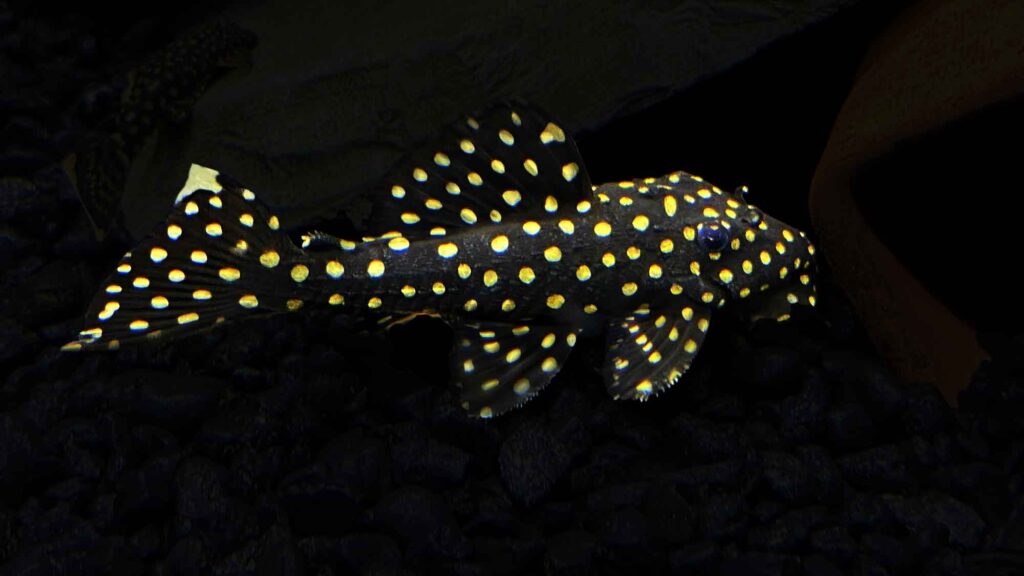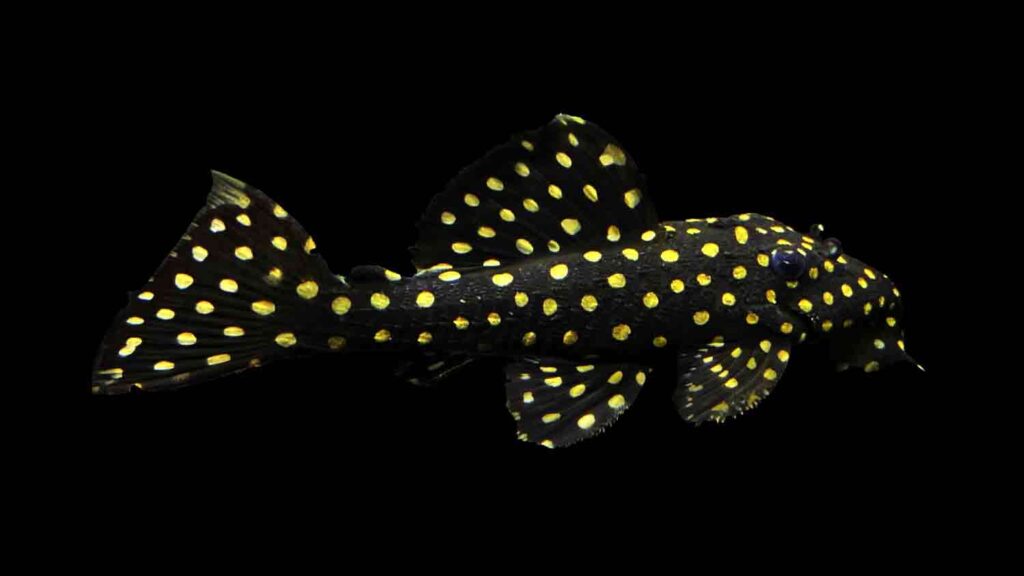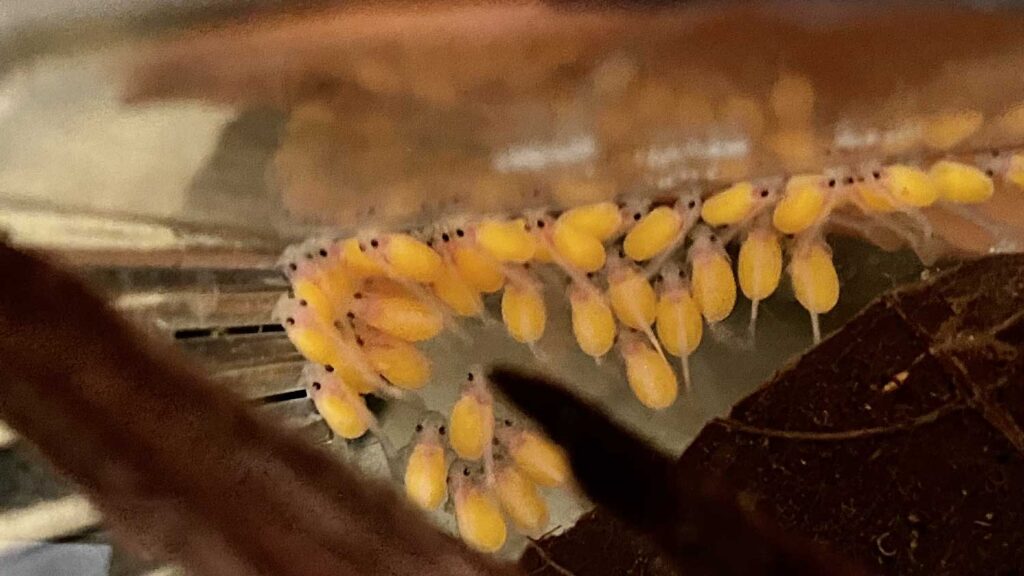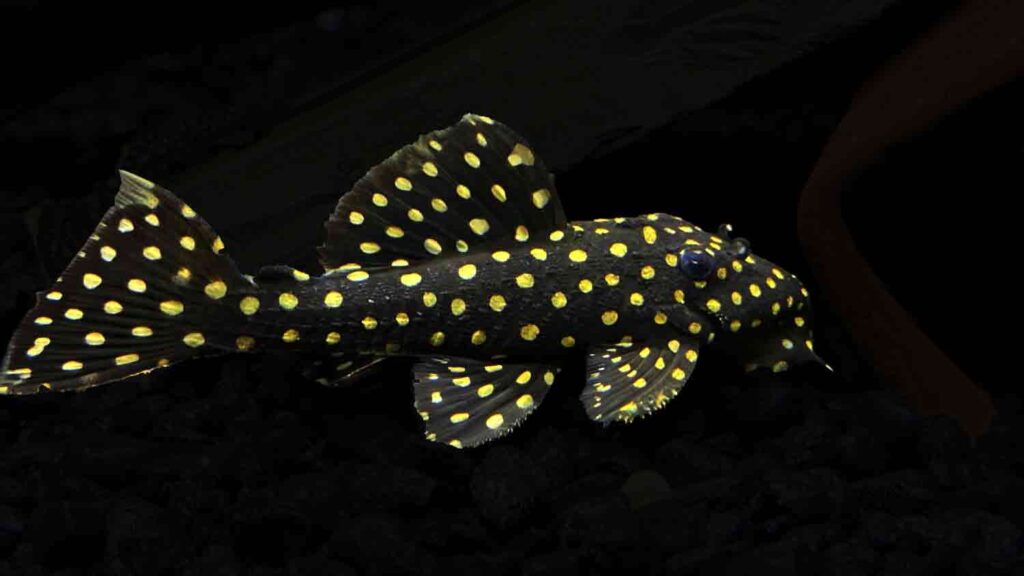Galaxy Pleco (Leporacanthicus galaxias(L029)) is one of the most beautiful pleco fish in the aquarium hobby. They are a very popular community tank species that has been in the hobby for a long time. Despite the popularity of this fish, We’ve seen a lot of incorrect information shared online about this species. We have seen many new aquarists follow these inaccurate guides which result in disastrous events in their tanks. These fish are hardy and can tolerate different environments, but it is important to create a healthy tank for these guys to thrive.
In this article, You will find all the information you need about Galaxy Pleco. You’ll learn about their diet, size, ideal tank size, lifespan, tank mates, and more!
Species Profile & Overview
In the wild, Galaxy Pleco (L029 Pleco) can be found in the Tocantins River in Para, Brazil. They are one of the most beautiful armored catfish of the Loricariidae family.
Members of this family have an armored back that protects them from predators that swim in the region. Their body shape is perfectly adapted to swim under the rocks and hide. Many aquarium owners purchase this fish for its unique look and pattern.
The rivers and water bodies Galaxy Pleco are living in are packed with driftwood, plant matter, and big boulders. The water stays warm, clean, and well oxygenated throughout the year. Creating an environment like this in the tank will help your fish thrive.
The size and patterns of this fish are the reason most hobbyists try to put their hands on it. Due to this, they are a little bit pricey when they become available in stores.
Appearance:

This beautiful pleco is one of the darkest freshwater plecos that you can find. They are completely covered with a beautiful black color and bright white dots. These dots are very visible which resemble stars in a dark night; this is why this fish is called Galaxy Pleco. The contrast between the two main colors makes them quite eye-catching.
The figure above shows the general mold of the plecos. They have a thick head and body which slowly get thinner towards the tail fin. They have 2 eyes at the top of the head where they can monitor the water column for predators.

Of the 8 fins, plecos have, the dorsal fin and tail fin are the most pronounced. All fins have the same unique patterns and colors as the rest of the body. They become more vibrant when they are not under stress and have peaceful tank mates.
Adult Size
Adult Galaxy Pleco size is about 8 – 8.5 inches in length. This means they are one of the larger plecos that can only live in larger aquariums.
However, there are reports that some individual specimens have reached even bigger sizes. This happens in rare cases and is not common among all Galaxy Plecos.
Lifespan
In pristine conditions, Galaxy Pleco lifespan is about 10 -12 years. This means they need a long-term commitment.
Without a well-maintained tank, they can get diseases that might result in a shortened lifespan.

Behavior and Temperament
Galaxy Pleco are passive and shy fish that are mostly hiding under the rocks or other decorations. These fish are nocturnal and will mostly come out to feed during the night. Depending on your tank setup, you might rarely see them during the daytime or when the lights are on.
However, they will also come out during the day when they feel safe or have a strong motivator like, adding their favorite food to the tank. As mentioned above, these fish are nocturnal but it doesn’t mean that’s the only time they will come out of their hiding spots.
The male specimens are known to get territorial and fight over territory with other bottom-dwelling fish. When you have more than one male in your aquarium you might see some aggression. Males will fight over caves and space in the tank. Compared to males. females are more passive and will not fight with each other or the males.
Having more caves and hiding spots will prevent aggression among males. You will need to add at least a pleco cave for each male that you have in the tank. When males get enough caves they will each pick a cave and protect it from others.
Galaxy Pleco Care
Galaxy Pleco Care is easy as this fish is not very demanding. These bottom-dwelling catfish will easily adapt to life in the aquarium. That said, you will still need to make a few adjustments to your aquarium to make their life easier.
They will also need a special diet that is as close to what they get in the wild as possible. This will help your fish live a long, happy life!
For an ideal living environment and care, you will need to follow the key points we mentioned below.
Tank Size
The minimum tank size for a single L029 Galaxy Pleco is 55 gallons or more. Juveniles can live in smaller aquariums but you will soon have to upgrade as they grow. It is always best to have a larger tank right from the beginning.
Even though 60 gallons is a good size for this fish, if possible, we recommend having a bit larger tank. Especially when you want to house more plecos in a tank. These fish need more floor space that naturally comes with bigger aquariums. bigger aquariums are also more stable when it comes to tank parameters which is a plus point.
Ideally, a tank that has a more floor surface area is better than a tank that can hold more water. This means, for plecos, wider aquariums are much better than tall aquariums. Wide aquariums have more floor area and you can easily create even more surfaces by adding more rocs, slates, tiles, and other decorations.

Tank Setup:
The L029 Plecos are shy fish and will need lots of hiding spots in the tank. You can place artificial ornaments or natural decorations to create a natural habitat for them. Your tank setup has a direct impact on the stress levels of this fish.
You can use artificial or natural decorations to create lots of hiding spots for your pleco to feel safe. However, we highly recommend using natural decorations as they provide many benefits to the tank. Placing a large number of rocks and driftwood will make your pleco feel safe.
Having natural wood and rocks will also help you maintain balanced aquarium parameters. You should also place a few pleco caves in your tank so your pet pleco can hide in during the daytime.
The tank’s substrate is another important topic to think about. These fish are living at the bottom of the tank and have a very soft belly. This means they will need to have a very soft substrate. Sand is the ideal substrate but you can also use pea gravels that are small in size. Most planted substrates are also good options for pleco tanks. If you are planning to have plants then a planted substrate can be used in your pleco tank.
Plants are required for any ecosystem to function properly. Aquatic plants will clean your tank of contaminants while providing plenty of hiding places for your fish. You can use floating plants or any other type of aquarium plant to make your aquarium more appealing and functional.
Water Parameters:
Galaxy Pleco comes from warm rivers that are rich in oxygen. These rivers are filled with driftwood and other decaying plant matter that provides a natural food source for creatures living there. The decaying driftwood will cause the water to become slightly soft and acidic. However, These fish can tolerate a wider range of water parameters than what they have in nature.
Below are the tank parameters you can keep L029 Plecos in:
- Temperature: 71 – 78 Degrees Fahrenheit
- PH: 5.6 – 7.0
- TDS: 60 – 120 PPM
If your tap water is ph neutral we highly recommend frequent water changes to maintain a perfect neutral ph in the tank. Unlike other fish, Plecos can handle large water changes up to 90% when the TDS between tap water and tank water is not very different. The TDS meter will let you know how much dissolved solids are in your tank’s water. and when you might need to perform a water change.
Lighting:
When the aquarium setup is done properly, Galaxy Pleco can adapt to any lighting conditions. These fish prefer to hide during the day and come out when light levels are low. It is best to select the right in accordance with the kinds of plants you are keeping in the tank.
Filter System:
L029 Pleco needs clean water, so an established tank is necessary. When filtration of your tank can’t keep the water in pristine conditions, your fish might face health issues. They might even get internal or external infections, diseases, or even die.
Common Diseases and Prevention
When tank parameters are not in favor of Galaxy Pleco, they tend to get ill. Long periods of stress will also cause diseases in this fish. They are also vulnerable to all common aquarium diseases that any new fish might carry into your tank.
The best way to prevent diseases is to never add new fish or plants to your tank without quarantining them properly. Doing this will drastically reduce the risk of tank epidemics. Keeping your tank clean is also very important. When uneaten food is left in the tank, it will increase the risk of bacterial infections and might even cause internal or external worms.
Diet and Feeding Requirements
Galaxy Pleco are omnivores but they seem to like to feed more of the meaty foods than plant based. While their main food should be protein-based they will also need plant based foods in their diet. Every now and then, they might also eat low amounts of algae and biofilm grown naturally in the tank. However, the L029 Pleco s aren’t algae eating fish so you might need to get some other algae eater fish to keep your tank algae-free.
This fish will constantly scavenge in the tank for food so you’ll need to feed them once or twice a day. Live or frozen foods like bloodworms, brine shrimp, tubifex, prawns, shrimps, and other small creatures make great protein choices for them. They will consume all of the above-mentioned protein sources as long as it fits their mouth.
Commercially produced fish foods like sinking pellets, shrimp wafers, and algae wafers are the ideal food to feed your pleco daily. A mix of these dry foods will nourish your fish with all the nutrition it needs. High-protein pellets or fish flakes mixed with a low amount of plant-based foods are an ideal mixture to feed them.
Commercial foods mixed with fresh or frozen foods should be the main diet they receive daily. Make sure to buy sinking fish foods so they can reach the bottom of the tank where plecos scavenge for food. Feeding should be done at night and only feed as much as they eat all by the morning.
Breeding Galaxy Plecos

Breeding L029 Pleco can be done in aquariums when the conditions are right. However, breeding Galaxy Pleco is a delicate and sometimes frustrating process.
In order to breed these fish, you will need your L029 Pleco to be mature and at least 3-4 years old. Once you confirm you have at least one male and one female in your breeding group, you can start to condition your fish for breeding.
If you have more males in your tank, then make sure that each male has a cave available in the tank for them. The rule of thumb is to add at least one cave per each male if not more.
L029 Pleco are cave breeders which means they need caves to breed. The cave should be slightly bigger than the male’s body; but, small enough that he can trap the female inside.
After the male finds a suitable cave, he will clean it out and wait for the female to arrive. The male will then trap the female and will not let her leave the cave until she lays eggs.
The female lays around 50 to 150 eggs depending on female size.
Once eggs are laid, the female leaves the cave, and then he will fertilize the eggs. It’s the male job to guard the eggs until they hatch. During this time, the male cleans the eggs and fans them so the eggs don’t go bad or get mold.
The eggs usually hatch after 3 – 4 days of being laid.
After hatching, the fry usually stay at the back of the cave and feed on their egg sacks for the next few days. The male will keep the fry in the cave for another 10-12 days until they are fully developed and ready to leave.
Once the fry are strong enough, they will escape the cave and will attach to driftwood or glass in the aquarium. Most aquarists will transfer the fry to a small container in the same tank before they leave the cave on their own. This is to prevent the breeding tank to get over populated and to target feeding the fry to grow faster.
Galaxy Pleco Tank Mates
Galaxy Pleco can make a great addition to any community tank as long as they have an adequate bottom space. The tank setup has a direct effect on the behavior of your fish. To make your tank safe for L029 Pleco and other tank mates you should pay close attention to the “Tank Setup” section of this article.
Galaxy Pleco can live with most South American aquarium fish. However, it is wise to choose similarly sized fish that are not very aggressive. This species is a bottom dweller, so it will not go after any fish that is swimming in the water column. The key to selecting the right tank mates for L029 Pleco is to select fish based on their aggressiveness and water parameter requirements. Here are some good tank mates you can keep with your pleco:
- Angelfish
- L397 Pleco
- L333 Pleco
- Zebra Pleco
- Discus
- GBR Fish
- Neon Tetra
- Other Tetras
- Other Plecos

Conclusion
You’ve now learned all the fundamentals of Galaxy Pleco care and are ready to confidently take care of your pet pleco. These fish are fairly passive and will not disturb other tank mates. The L029 Pleco needs a clean and warm tank to thrive. So as long as you follow the recommendations we made in this guide you should not face any issues.